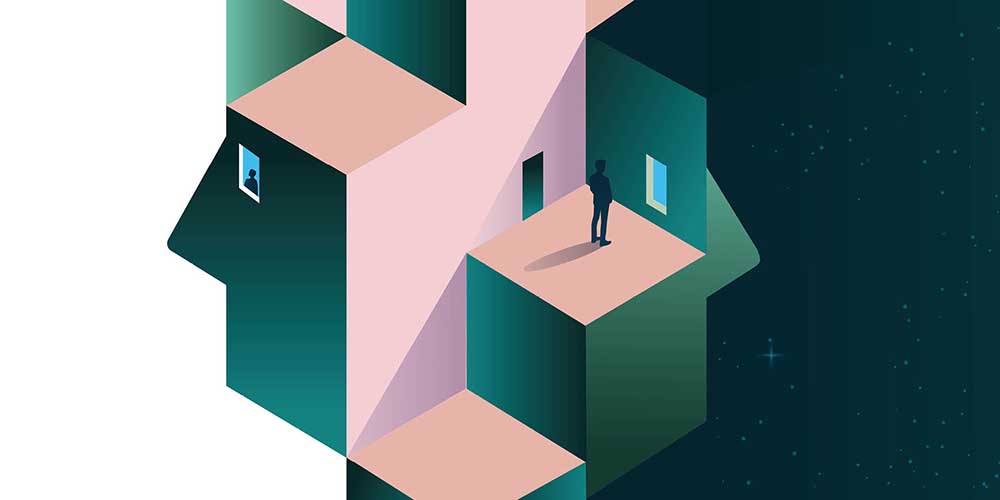Magazine
It’s a result that most faculty and staff would have expected after watching their students endure the disruption of COVID-19:
“Due to the long-lasting pandemic situation and onerous measures such as lockdown and stay-at-home orders, the COVID-19 pandemic brings negative impacts on higher education. The findings of our study highlight the urgent need to develop interventions and preventive strategies to address the mental health of college students.”
That was the finding of an interview survey study published in September 2020 in the Journal of Medical Internet Research. It likely comes as no surprise to most higher education professionals. Even for students whose families did not face illness, death, or job loss directly, the changes in routine and surroundings alone would be enough to have a deep impact.
“Picture students in a basement,” says Todd Monger, executive director of student development at North Central University in Minneapolis, Minnesota. “No windows, no social cues — even their movies they watch are streamed, so they are never interrupted by the 10:00 p.m. news cueing them it might be time for bed. Students are losing track of time, sleep schedules, eating schedules, and the list goes on. They are socially ‘weightless’ or numb because they have lost social grounding.”
Monger wonders if students’ social muscles are atrophying during this time in ways that won’t quite become clear until a truly post-pandemic era, like when an astronaut returns to Earth and can’t bear up against gravity. There are certainly signs that students are struggling.
An informal survey of academic leaders from 32 CCCU institutions at the end of 2020 revealed that 66% of these leaders have seen similar or even decreased demand for mental health services from students seeking help (whether in-person or virtually) compared to previous years. Yet the same survey showed that 78% of those leaders have seen significant increases in signs that students are struggling (such as missed or incomplete assignments, grade levels below average for the class, higher absenteeism, etc.).
National data tell a similar story. In their fall 2020 survey of student success, Hobsons found that more than half of college students reported their learning experience worsening due to the pandemic and that 68% stated that COVID-19 had negatively affected their mental health. However, 77% of all students surveyed indicated that they had not availed themselves of their college’s mental health services.
One could make a few different assumptions about what these statistics mean. It could be that students are experiencing more anxiety and depression but are trying to find their own coping mechanisms without the aid of campus health care leaders. It could be that students are reluctant to get the help they need because they’re afraid to go out due to the pandemic but also feel uncomfortable with telehealth services. It could be that the “basement effect” Monger suggested is just disrupting enough for students to struggle in class but not enough for them to feel the need to seek help.
Regardless of the assumptions, CCCU leaders are continuing their mission to help students flourish in the midst of all circumstances. They model and encourage rhythms not of assumption and reaction, but of observation and response.
“Caring, consistency, and constancy,” says Tamela Turner, campus counselor at Judson College in Marion, Alabama. Turner emphasizes the value of reaching out to students on a regular basis, demonstrating clear availability and openness to listening. “We didn’t stop [offering counseling sessions] when students were on break,” she says. “We knew they were coming back, so we told them, ‘we’re still here.’”
Turner places the priority not on predicting how students feel or will feel in the months to come, but on creating spaces and opportunities for them to communicate, process, and seek counsel.
Irene Kraegel, director of the Center for Counseling and Wellness at Calvin University in Grand Rapids, Michigan, takes a similar approach. She notes that it isn’t just mental health services seeing lower participation at Calvin; engagement in student activities is lower now than it was during pre-pandemic times.
“I think time will tell,” she says. “Is [decreased enrollment in student mental health services] because students are suffering in silence and it feels like too much of a barrier to meet virtually? Some students are feeling like they’re in living situations where they don’t have the privacy they need for something like virtual therapy. We do offer in-person rooms that students can use for their virtual sessions at our center but there are students who aren’t living in town — they’re studying remotely. So I think there’s a lot that goes into this, especially since we know that it isn’t just mental health services that are experiencing this [lower participation].”
The key, many are finding, is cultivating intentional connection amongst peers. At Azusa Pacific University in Azusa, California, the university’s counseling center has launched a Peer Educator program. Lori Lacy, the counseling center’s director, says that six undergraduate students serving as interns for the center have taken on the task of promoting mental wellness to other students as part of this program. The students receive academic internship credit in exchange for working 2,000 hours a year providing outreach to the APU student community.
“They can get through [to their fellow students] in a way that professionals can’t always do,” Lacy explains.
Kraegel at Calvin University has found the same to be true. “Being able to switch to a virtual service model has been really important,” she says. “Most of what we’ve done in the past we’ve been able to continue to do in a virtual format. We did, this year, bring in a new peer support tool — an app that students could use to support each other virtually. … It’s been an opportunity for students to digitally reach out to each other and show support. That’s something we’ve been working toward for a long time, but I think the timing did end up working out well.”
“There have been a lot of students talking and posting about loneliness, anxiety, and depression,” says Andy Storms, vice president of student affairs and the residence director of Strong Hall at Ozark Christian College. “But I know that, going into November, our counseling numbers were down. I think everyone was talking about [mental health] but they didn’t seek professional help…which could be a recipe for disaster…or it could be that, sort of by the acceptance of talking about it, [students are] getting the care they need and at least don’t feel alone.”
Peer-to-peer connection seems particularly effective at helping students combat isolation because of the simple fact that the student volunteers are in the same position as their peers — facing a complete shift in what they expected their college experience to entail. While it doesn’t replace the need for professional mental health services, it does provide a unique and meaningful way to share fears and anxieties.
These peer-led collaborations aren’t the only way connections seem to be making a difference in student overall well-being. Campuses across the country have found that, especially now, embracing the theology of bearing one another’s burdens cannot be overstated.
Storms says that while Ozark outsources professional counseling when student needs can be better met by off-campus professionals, there are many faculty members with pastoral counseling hearts willing to lend an ear to students.
Lacy at Azusa Pacific also notes that on-campus collaborations have provided resilient, meaningful partnerships in a time when so much feels fractured. For example, APU’s counseling center partnered with APU’s human resources department and provost office to provide all new faculty with training on both safety in the curricular setting and mental health awareness.
Lacy says that these training courses speak to specific signs of distress that faculty members can look for while educating students online. For example, are students engaging? Are they no longer turning their video cameras on during the Zoom meetings? Are they saying things like, “I just don’t see the point of doing this assignment”?
“We give faculty language to use,” Lacy says. “[Statements like] ‘I feel how hard this is for you. I’ve felt that way before. I’ve found that it’s helpful to go talk to someone about it.”
In this season of tremendous isolation, distance, and uncertainty, counselors and activities directors on many Christian campuses know that community-building is still possible. It’s difficult, and perhaps the mechanisms aren’t ideal, but staff efforts are bearing fruit. Of the more than 4,800 CCCU students across the U.S. and Canada who responded to the “Thriving Quotient” survey in the fall, 78% agreed or strongly agreed with the statement, “Overall, my instructors have shown care and concern for me as they respond to COVID-19” (for more on this, see “Campus Responses to COVID-19”). Peer-centric initiatives are further normalizing conversations around anxiety, depression, and other health issues. Perhaps these efforts and their results encapsulate one of the great opportunities on college campuses today: the chance to acknowledge the difficulties of the times, lament their losses, and mine their depths for the abundant life still promised all the while.
Abby Perry is a freelance writer with work in Christianity Today, Sojourners, and Texas Monthly. Find her in Texas with her husband and two sons, and on Twitter at @abbyjperry.




